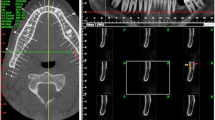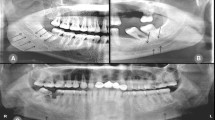Abstract
Objectives
Bifid mandibular canal (MC) is an anatomical variation of the MC. This study aimed to assess the prevalence and shape of bifid MC in an Iranian population.
Materials and methods
A total of 681 patients who had undergone cone-beam computed tomography (CBCT) for different purposes between 2018 and 2020 were evaluated. After detection, bifid MCs were classified into four types forward, buccolingual, dental, and retromolar. CBCT images were assessed by two oral and maxillofacial radiologists. Data were analyzed by SPSS using an independent t-test and Chi-square test.
Results
Bifid MC was found in 23 (3.4%) out of 681 patients, with a mean age of 32.21 years. Ten patients (1.5%) had a bifid MC on the right side, 6 (0.9%) on the left side, and 7 (1%) bilaterally. However, no significant correlation was found between laterality and the prevalence of bifid MC (P > 0.05). Bifid MC was found in 8 males (34.8%) and 15 females (65.2%). Gender had no significant correlation with the prevalence of bifid MC (P > 0.05). Forward type was the most common (n = 8, 1.2%) followed by buccolingual (n = 5, 0.73%), dental (n = 2, 0.3%), and retromolar (n = 1, 0.14%) types.
Conclusion
According to the present results, bifid MC was not uncommon in the Iranian population of the present study, and forward type was the most common, followed by buccal and then dental bifid MCs. There was no significant correlation between sex and age with bifid MC but bifid MC was detected more frequently in females than males, and it was seen unilaterally in a higher percentage of the cases.

Similar content being viewed by others
Data availability
The data analyzed during the current study will be available from the corresponding author upon reasonable request.
References
Correr GM, Iwanko D, Leonardi DP, Ulbrich LM, Araujo MRd, Deliberador TM. Classification of bifid mandibular canals using cone beam computed tomography. Br Oral Res. 2013;27:510–6.
Kang J-H, Lee K-S, Oh M-G, Choi H-Y, Lee S-R, Oh S-H, et al. The incidence and configuration of the bifid mandibular canal in Koreans by using cone-beam computed tomography. Imaging Sci Dent. 2014;44(1):53–60.
Rashsuren O, Choi J-W, Han W-J, Kim E-K. Assessment of bifid and trifid mandibular canals using cone-beam computed tomography. Imaging Sci Dent. 2014;44(3):229–36.
Fu E, Peng M, Chiang CY, Tu HP, Lin YS, Shen EC. Bifid mandibular canals and the factors associated with their presence: a medical computed tomography evaluation in a Taiwanese population. Clin Oral Implant Res. 2014;25(2):64–7.
Rouas P, Nancy J, Bar D. Identification of double mandibular canals: literature review and three case reports with CT scans and cone beam CT. Dentomaxillofac Radiol. 2007;36(1):34–8.
Zhang Y-Q, Zhao Y-N, Liu D-G, Meng Y, Ma X-C. Bifid variations of the mandibular canal: cone beam computed tomography evaluation of 1000 Northern Chinese patients. Oral Surg Oral Med Oral Pathol Oral Radiol. 2018;126(5):e271–8.
Naitoh M, Hiraiwa Y, Aimiya H, Ariji E. Observation of bifid mandibular canal using cone-beam computerized tomography. Int J Oral Maxillofac Implants. 2009;24(1).
Freitas GBD, Freitas e Silva AD, ManhãesJúnior LRC, Junqueira JLC. Prevalence evaluation and classification of bifid mandibular canals in CBCT exams in different facial types. Revista de Odontologia da UNESP. 2018;47:85–91.
Nortjé C, Farman A, Grotepass F. Variations in the normal anatomy of the inferior dental (mandibular) canal: a retrospective study of panoramic radiographs from 3612 routine dental patients. Br J Oral Surg. 1977;15(1):55–63.
Langlais RP, Broadus R, Glass BJ. Bifid mandibular canals in panoramic radiographs. J Am Dent Assoc. 1985;110(6):923–6.
Zografos J, Kolokoudias M, Papadakis E. The types of the mandibular canal. Hell Period Stomat Gnathopathoprosopike Cheir. 1990;5(1):17–20.
Sanchis J, Peñarrocha M, Soler F. Bifid mandibular canal. J Oral Maxillofac Surg. 2003;61(4):422–4.
Elnadoury EA, Gaweesh YSE-D, Abu El Sadat SM, Anwar SK. Prevalence of bifid and trifid mandibular canals with unusual patterns of nerve branching using cone beam computed tomography. Odontology. 2022;110(1):203–11.
Carter R, Keen E. The intramandibular course of the inferior alveolar nerve. J Anat. 1971;108(3):433.
Kuribayashi A, Watanabe H, Imaizumi A, Tantanapornkul W, Katakami K, Kurabayashi T. Bifid mandibular canals: cone beam computed tomography evaluation. Dentomaxillofac Radiol. 2010;39(4):235–9.
Naitoh M, Nakahara K, Suenaga Y, Gotoh K, Kondo S, Ariji E. Comparison between cone-beam and multislice computed tomography depicting mandibular neurovascular canal structures. Oral Surg Oral Med Oral Pathol Oral Radiol Endodontol. 2010;109(1):25–31.
Orhan K, Aksoy S, Bilecenoglu B, Sakul BU, Paksoy CS. Evaluation of bifid mandibular canals with cone-beam computed tomography in a Turkish adult population: a retrospective study. Surg Radiol Anat. 2011;33(6):501–7.
de Oliveira-Santos C, Souza PHC, de Azambuja B-C, Stinkens L, Moyaert K, Rubira-Bullen IRF, et al. Assessment of variations of the mandibular canal through cone beam computed tomography. Clin Oral Invest. 2012;16(2):387–93.
Okumuş Ö, Dumlu A. Prevalence of bifid mandibular canal according to gender, type and side. J Dent Sci. 2019;14(2):126–33.
Capote TSdO, de Almeida GM, Campos JÁDB. Retromolar canal associated with age, side, sex, bifid mandibular canal, and accessory mental foramen in panoramic radiographs of Brazilians. Anat Res Int. 2015;2015:434083.
Von Arx T, Hänni A, Sendi P, Buser D, Bornstein MM. Radiographic study of the mandibular retromolar canal: an anatomic structure with clinical importance. J Endod. 2011;37(12):1630–5.
Funding
None.
Author information
Authors and Affiliations
Corresponding author
Ethics declarations
Conflict of interest
The authors report no conflict of interest.
Ethical approval
This research was approved by the Research Ethics Committee of the Hamadan University of Medial Science. (Approval number: IR.UMSHA.REC.1397.800).
Human and animal rights
This article does not contain any studies with human or animal subjects performed by any of the authors.
Additional information
Publisher's Note
Springer Nature remains neutral with regard to jurisdictional claims in published maps and institutional affiliations.
Rights and permissions
Springer Nature or its licensor (e.g. a society or other partner) holds exclusive rights to this article under a publishing agreement with the author(s) or other rightsholder(s); author self-archiving of the accepted manuscript version of this article is solely governed by the terms of such publishing agreement and applicable law.
About this article
Cite this article
Shokri, A., Ehsani, A. & Yousefi, A. Prevalence of bifid variations of the mandibular canal in an Iranian population using cone-beam computed tomography. Oral Radiol 39, 779–783 (2023). https://doi.org/10.1007/s11282-023-00698-3
Received:
Accepted:
Published:
Issue Date:
DOI: https://doi.org/10.1007/s11282-023-00698-3




